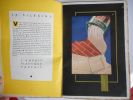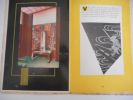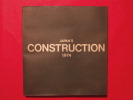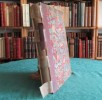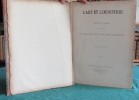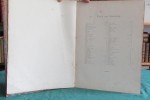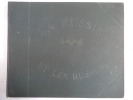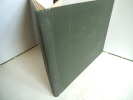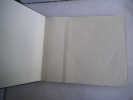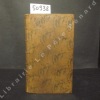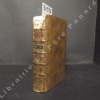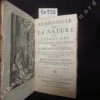-
Type
Any type (2)
Art print (7)
Book (31283)
Disk (1)
Drawings (7)
Engraving (9)
Magazine (129)
Old papers (1)
Photographs (14)
Posters (4)
-
Latest
Last 24h (25)
Last 3 days (45)
Last month (382)
Last week (26)
-
Language
Dutch (1)
English (53)
French (31357)
German (6)
Italian (18)
Japanese (2)
Portuguese (9)
Spanish (11)
-
Century
16th (16)
17th (56)
18th (213)
19th (1574)
20th (9522)
21st (1707)
-
Countries
Belgium (9481)
Brazil (7)
Canada (108)
China (3)
Côte d'Ivoire (67)
Denmark (218)
France (18466)
Germany (1)
Greece (1)
Italy (37)
Switzerland (3068)
-
Syndicate
ALAC (99)
CLAM (41)
CLAQ (94)
CNE (3)
ILAB (10914)
NVVA (1171)
SLACES (1171)
SLAM (8370)
SNCAO (9)
Baqilique St-Julien de Brioude
Editions Xavier Mappus. 1958. In-8. Broché. Bon état, Couv. défraîchie, Dos satisfaisant, Mouillures. Non paginé, environ 20 pages augmentées de nombreuses planches en noir et blanc .. . . . Classification Dewey : 720-Architecture
Classification Dewey : 720-Architecture
BRECH -
Document ( v 1970) de 26 pages concernant des recherches historiques sur Brech. Inventaire détaillé de l' église et des chapelles , photocopies d' actes manuscrits anciens, recherches sur la généalogie, la toponymie.
BRECH - Eglise et chapelles .
Document ( v 1970) de 26 feuilles photocopie de texte manuscrit concernant l' église et 9 chapelles de Brech. L' auteur en fait une description tant extérieure qu' intérieure méticuleuse. Il note aussi le fruit de ses recherches historiques sur chaque chapelle. Langue: Français
[ Carnet de cartes postales anciennes ] Souvenir du Château de Castelnau de Bretenoux (Lot)
1 vol. in-12 à l'italienne br., 10 cartes postales noir et blanc, avec légendes, s.d. (circa 1910 )
Bon état
(catalogue) Textile, acoustique, architecture - Texaa
1984. Texaa, 2010. Format 17x24 cm, broche, 198 pages. Tres bon etat.
Catalogue fait d'exemple d'utilisation des produits de la societe.
Château de Bourlémont [ Album de 24 photographies ]
1 album petit in-4 oblong pleine percaline rouge recueillant 24 photographies format 17 x 12 cm, s.d., circa 1920-1930
Rare album recueillant 24 vues extérieures et intérieures du château de Bourlémont, château médiéval de la commune de Frebécourt à l'ouest du département des Vosges. Etat très satisfaisant (couv. frottée, restaurations en garde, bon état par ailleurs)
Cottages et contructions rurales
Albin Michel Le guide du constructeur Cartonnage d'éditeur 0 in-4 cartonné, premier plat illustré, 170 pp dont 93 planches inédites de façades-coupes-plans-devis, modèles de contrats et devis descriptifs, album de 63 cottages et constructions rurales, couverture piquée, quelques rousseurs sur les tranches, intérieur frais, sans date, bon état Livraison a domicile (La Poste) ou en Mondial Relay sur simple demande.
De la decoration plastique dans l'art moderne - Etablissements Louis Van Malderen
n.d.. Paris, sans date. Format 15x23 cm, cartonnage souple, 40 pages. Joint un document de 4 pages sur le mode d'emploi du "Silimath". Etat d'usage. Etat passable.
De La Théorie , de La Pratique et de La Construction d'un Mur Solaire Suivi De Quelques Idées et Applications Pour une Maison Solaire
Lys Utovie 1980 Grand In 8 Supplément à TRIPOT . Nombreux schémas explicatifs . Ecologie . - 36 p. + 16 p. , 250 gr.
Couverture souple Bon État . 1ère Édition
Description de la cathédrale de Milan
Imprimerie des jeunes artisanes 1895 64 pages in12. 1895. Broché. 64 pages.
Etat Passable couverture défraîchie et salie pages uniformément jaunies
DESCRIPTION DE LA FAÇADE ET DE L'INTÉRIEUR DE LA CATHÉDRALE DE MILAN.
Milan Chez Louis de Jacques Pirola 1874 in 8 (22,5x15,5) 1 fascicule broché, couverture rose imprimée, 56 pages. Une planche gravée hors-texte. Bon exemplaire ( Photographies sur demande / We can send pictures of this book on simple request )
Bon
DESCRIPTION et HISTOIRE du CHATEAU D'ARQUES. Nouvelle édition.
Paris LIBRAIRIE DES IMPRIMERIES RÉUNIES (ancienne maison Morel), sans date 0 un fascicule in-8°, 16 pp., couverture bleue titrée noir. (couverture et feuillets un peu roussi-e-s). Un plan dans le texte et un dessin en hors-texte.
DESCRIZIONE DI ROMA MODERNA formata nuovamente con le Auttorita del Card. Cesare Baronio, Alfonso ciaconio, Antonio Bosio e Ottavio panciroli e altri celebri scrittori. TOME II (sur 2).
In Roma nella Libreria di Michel'Angelo et Pier Voncenzo Rossi all Insegna della Salamandra 1719. Très fort in-8 1f n ch 2-792pp. Plein vélin ivoire, dos à nerfs avec le titre manuscrit, rel époque. Orné d'un beau titre frontispice allégorique, 25 figures dans le texte (médailles), 63 grandes vignettes finement gravées dans le texte, 11 belles planches dépliantes de vues et monuments. Petit manque de vélin sur la coupe verticale du 1er plat, manque 3,5 x 14 cm sur la planche en regard de la p668, 10 feuillets sont absents correspondant aux pages 435-436, 445-446, 455-456, 457-458, 519-520, 521-522, 533-534, 535-536, 537-538 et 539-540.
Tome II seul, consacré à la description des monuments chrétiens de Rome (le 1er volume décrit les monuments civils) avec, à la fin, une chronologie des Papes depuis Saint Pierre jusqu'à Clément XI. Ce guide, magnifiquement illustré, donne la description de nombreux édifices qui avaient été négligés dans d'autres ouvrages de ce genre.
Design scandinave - Vente PIASA 2016
PIASA, Paris, mercredi 17 février 2016. In-4, broché, 200 pp. env.
Illustrations en noir in texte et nombreuses planches couleur. --- Plus d'informations sur le site archivesdunord.com
Phone number : 01 42 73 13 41
EL PALACIO DE LA EXCMA. DIPUTACION PROVINCIAL DE BARCELONA
1929 BARCELONA, 1929. edicion de la Socieda de ATRACCION de FORASTEROS DE BARCELONA, NUMEROSAS FOTOGRAFIAS B/N Y BONITAS LAMINAS A COLOR DEL MONUMENTO. ILUSTRACIONES DE H. DE J. THOMAS. 68 +80 PAGS., 24X17,bon état,
texte en espagnol,français,anglais,allemand,bon état Remise de 20% pour toutes commandes supérieures à 200 €
Havenarchitectuur
Rotterdame Kunststichting Uitgeverij Broché 1982 In-8, (22x22 cm), broché, couverture illustrée, 144 pages, nombreuses photographies et schémas en noir et blanc, texte en néerlandais ; couverture légèrement salie, une pliure sur le dos, une étiquette sur le 4e plat, bon état général. Livraison a domicile (La Poste) ou en Mondial Relay sur simple demande.
Hommage à René Lalique 2010 - 150e anniversaire
Lalique, Paris, 2010. In-4, broché sous couverture argentée et illustrée, 52 pp. René Lalique (1860-1945) - Chronologie - La cire perdue/The Lost Wax Technique - Lalique collection d'art.
Illustrations et planches en noir et en couleurs.Ouvrage bilingue français/anglais. --- Plus d'informations sur le site archivesdunord.com
Phone number : 01 42 73 13 41
Hôtel-Dieu du Creusot.
1896 Protat Frères, Macon, 1896. Un volume in-4 broché, 75 pages + 3 plans double page, nombreuses photographies in-texte. Bel état malgré un léger manque à la coiffe supérieure.
La librairie est ouverte du mardi au samedi de 9h30 à 12h30 et de 13h30 à 19h00. Commandes par courriel ou téléphone. Envoi rapide, emballage soigné.
Japan's construction 1974
1974 Overseas construction association of Japan, inc. Carré, broché, jaquette, 172p + [64p] bon état
"Contents : japan's construction buiseness and its present status - taday's building and civil engeneering technologies - construction equipement in Japan - list of the members of the Overseas construction association of Japan, inc - map of Japan : highways & railways; dams, water powerstations & others; bridges; warfs, reclaimed & office buildings; city halls, museums & others; hotels; schools, laboratories & hopitals; sports & leisure facilities; apartement houses; distribution centers & warehouses; power plants, factories & shipyards; airports, broadcasting center & others; overseas construction. Nombreuses photos couleurs et n&b."
Phone number : 04 76 97 79 28
La mécanique navale
Anonyme Dos agrafé In-8 (21 x 27,5 cm.), dos agrafé, couverture illustrée, catalogue de pièce, non paginé, environ 15 pages, non daté, trois documents joints (dont un datant de 1952 et l'autre de 1967), illustrations noir et blanc in-texte; rousseurs sur les plats, par ailleurs bon état. Livraison a domicile (La Poste) ou en Mondial Relay sur simple demande.
L'Art et l'Industrie. Organe du progrès dans toutes les branches de l'Industrie artistique 1878/1879
2 années reliées en 1 volume. Deuxième année - 1878 - 96 planches. Troisième année - 1879 - 96 planches. Certaines en couleurs.Paris, Ducher et Cie. - 1878-1879.Reliure demi percaline. Dos totalement manquant. Les plats sont maintenus par de l'adhésif. Pas de rousseur. Bon état intérieur. Format in folio (39x29).
DIVERS
L'Art Roman
Paris Editions de l'Olympe 1996 In Quarto Collection " Les merveilles " . Au sommaire : - Glossaire - Jumièges - Caen - Ottmarsheim - Fontevraud - Vézelay - Saint-Gildas-de-Rhuys - Notre-Dame-de-Daoulas - Fontenay - Cluny - Paray-le-Monial - Angoulême - Clermont-Ferrand : Notre-Dame-du-port - Conques : Sainte-Foy - Moissac - Arles : Saint-Trophime - Saint-Sernin-de-Toulouse - Le Thoronet-Senanque-Silvacane - Saint-Michel-de-Cuxa . Illustré de, photographies en couleurs . Religion , spiritualité . - 158 p. , 950 gr.
Couverture rigide Très bon 1ère Édition
La Russie et les Russes
in 4 à l’italienne,reliure éditeur pleine toile verte, titre aux armes et filets sur le premier plat (dorure oxydée)Faux-titre, titre,206 pages illustrées en noir, photos de Jough frères, Maniati, Lazovsky, etc. Paris imprimerie de la société anonyme de publications périodiques, sans date (1890)
Les grandes dates de Notre-Dame de la couture, le Mans
Non précisé. Non daté. In-12. Broché. Bon état, Couv. convenable, Dos satisfaisant, Intérieur frais. Non paginé, environ 20 pages augmentées de nombreuses photos et illustrations en noir et blanc dans et hors texte.. . . . Classification Dewey : 720-Architecture
Photographies de Robert Chateau. Classification Dewey : 720-Architecture
Le Spectacle de la Nature, ou Entretiens sur les particularités de l'Histoire Naturelle, qui ont paru les plus propres à rendre les Jeunes Gens curieux, & à leur former l'esprit. Tome troisième, contenant ce qui regarde Les dehors et l'intérieur de la Terre (suite de la deuxième partie) - A Paris chez Les Frères Estienne 1780Un frontispice et 31 planches : plantes, poissons, rivières, animaux des montagnes, navigation: coupe de vaisseau, voilier, architecture navale, galères à voiles et à rames, barque de pêcheurs, poissons de mer et crustacés de mer, plantes marines, corails, taille des diamants, fossiles et pétrifications, orbite de la Terre autour du Soleil
1 vol. in-12 plein veau marbré - 575 pages - 1780 - A Paris chez Les Frères Estienne
coiffe supérieure arrachée, coiffe inférieure émoussée sinon bel état intérieur
 Write to the booksellers
Write to the booksellers


![[ Carnet de cartes postales anciennes ] Souvenir du Château de Castelnau de Bretenoux (Lot). Anonyme](https://static.livre-rare-book.com/pictures/CDL/36342_thumb.jpg)
![[ Carnet de cartes postales anciennes ] Souvenir du Château de Castelnau de Bretenoux (Lot). Anonyme](https://static.livre-rare-book.com/pictures/CDL/36342_2_thumb.jpg)
![[ Carnet de cartes postales anciennes ] Souvenir du Château de Castelnau de Bretenoux (Lot). Anonyme](https://static.livre-rare-book.com/pictures/CDL/36342_3_thumb.jpg)

![Château de Bourlémont [ Album de 24 photographies ]. Anonyme](https://static.livre-rare-book.com/pictures/CDL/45425_thumb.jpg)
![Château de Bourlémont [ Album de 24 photographies ]. Anonyme](https://static.livre-rare-book.com/pictures/CDL/45425_2_thumb.jpg)
![Château de Bourlémont [ Album de 24 photographies ]. Anonyme](https://static.livre-rare-book.com/pictures/CDL/45425_3_thumb.jpg)


